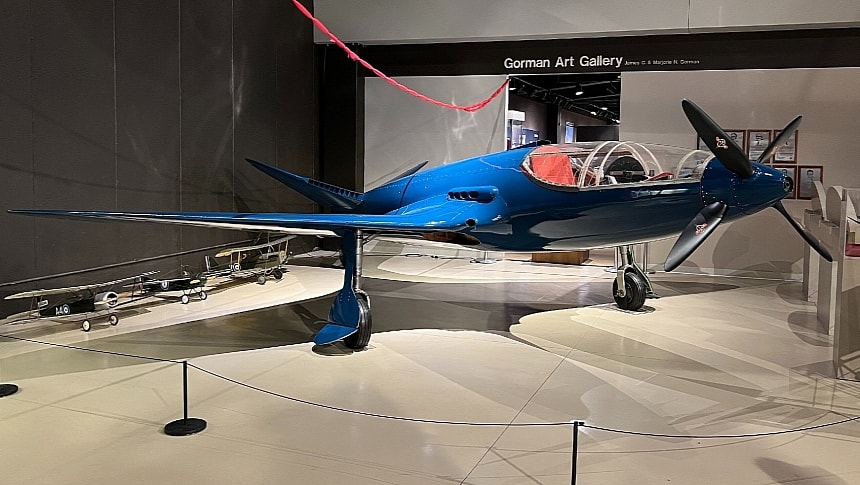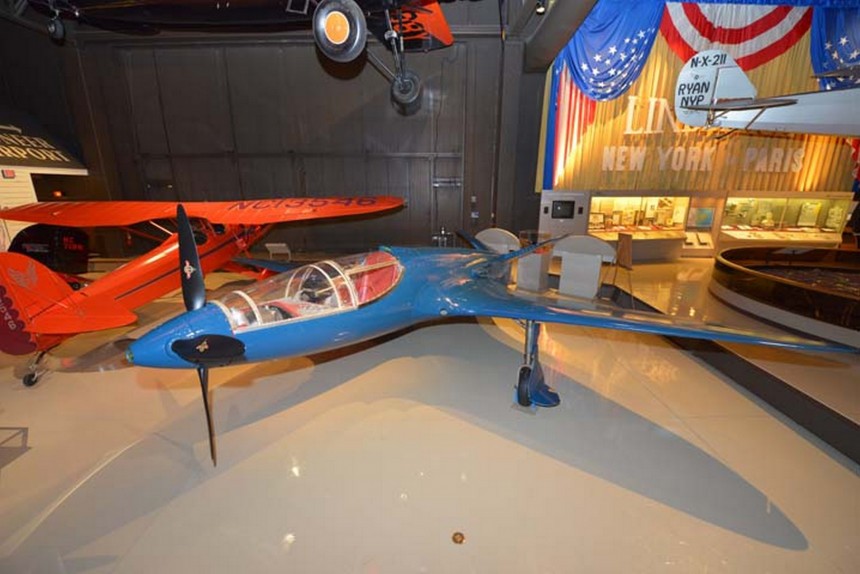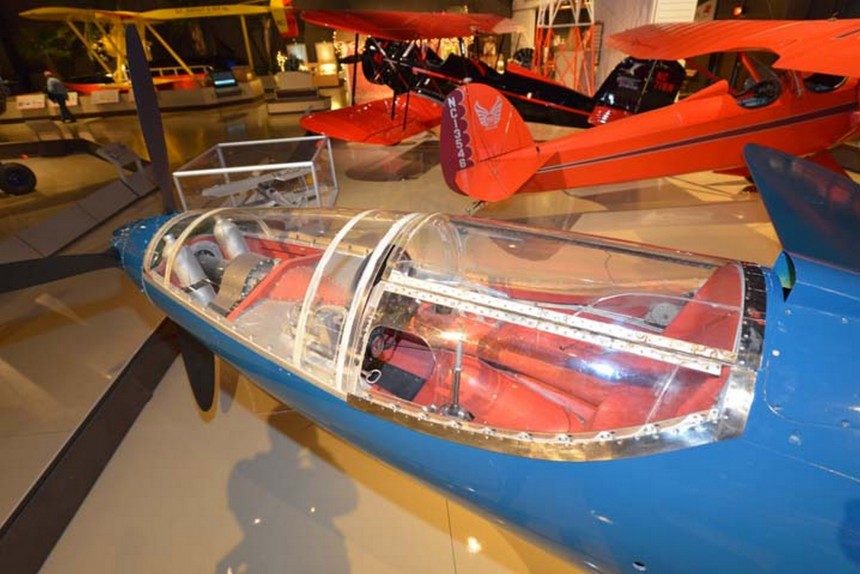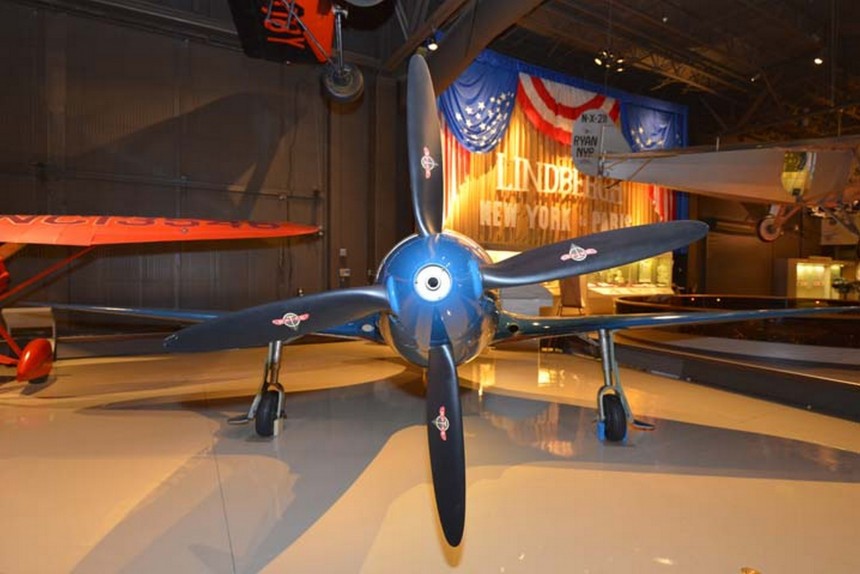When most people think of Bugatti, they think of the pop culture icon the brand only recently became in the 21st century. The suave, sophisticated manufacturers of the pound-four-pound fastest production motorcars ever to see the light of day. But even beyond Bugatti's previous history building world-class gentleman's racers and GT cars, the marquee has an even less talked about place in the early days of aviation. This is the tale of the Bugatti Model 100. The classic Bugatti racer formula given a propeller and a set of wings.
From some points of view, the Model 100 was an airplane that could've only been built by a Frenchman before a certain Austrian painter came in and ruined everything. Apart from looking like a flying baguette on first impressions, the Model 100 appears to exude a sort of chic and exuberance reminiscent of the very same Bugatti racers and GT cars that came to define the brand decades before Volkswagen group turned it into a rap music video on four wheels.
After three decades of success in Grand Prix racing and building luxury grand touring cars, the borderline mythical automotive powerhouse that was Ettore Bugatti was ready to bring his talents to the burgeoning paradigm of human-crewed aerospace. Though it was Bugatti's first attempt at his own bespoke aircraft, it wasn't his first run-in with aviation. During the First World War, the young Ettore Bugatti offered to supply the French government with straight-eight and twin straight-eight (U-16) engines for use in their aircraft.
So impressive were these engines that they caught the attention of a consortium of high-ranking US Army officers, who compelled the Duesenberg Motor Company of New Jersey to build Bugatti's engines under license in the United States. But the impetus for Ettore Bugatti's quantum leap from the road to the sky on his own terms was a chance to enter one of the most high-stakes air races in all of Europe in its day, the prestigious Deutsch de la Meurthe Cup Race.
Founded in 1909 by a French oil magnate, the same year Ettore Bugatti founded his eponymous company, the Deutsch de la Meurthe pitted Europe's brightest minds in aviation against each other in an attempt to build the fastest heavier-than-air piloted aircraft contemporary minds could create. With a very handsome cash prize awaiting the winner each year, not even the First World War and resulting Spanish Flu could stop the event from being held on and off from the 1910s through the mid-to-late 1930s.
With the spirit of speed in mind, Ettore Bugatti knew only a killer combination of a solid power-to-weight ratio and a supremely aerodynamic airframe would be enough to take home first prize when he first threw his hat in the ring starting in 1938. Little did anyone know it then, but the winds of fate had already decreed that the competition would never be held again. Clueless that the Second World War would soon make his efforts moot, Bugatti chugged along on his aerial speedster.
The mid-to-late 1930s marked a profound shift in how aircraft were designed and manufactured. Relentless trial and error combined with rigorous wind tunnel testing had given engineers a better understanding of flight by this stage. With this in mind, Ettore Bugatti knew that his tentative aircraft design needed to cut through turbulent air with as little aerodynamic drag as possible. To make this happen, Bugatti designed the fuselage of his aircraft to be as streamlined as could be manufactured.
With the same silhouette as a speeding bullet, Bugatti's design was set to look radically different, even compared to contemporary racing and fighter aircraft of the late 1930s. Add on an innovative 120-degree v-tail, and one can only assume Bugatti's plane, named the Model 100, looked like a spaceship to most people in the late 30s. With the preliminary design work now complete, Ettore Bugatti called upon the prominent Belgian aeronautical engineer and former World War I pilot Louis de Monge to be his lead designer and help finalize the blueprints before construction could begin.
Though its shape looked straight out of a Popular Science magazine cover of the period, the build materials Bugatti and de Monge chose to construct Model 100 out of were downright commonplace. Thin layers of balsawood and other lightweight hardwoods bonded made up the vast majority of the Model 100's airframe. Elsewhere, special aerospace-grade fabric covered portions of the plane's exterior, which was not covered by hardwood. In the days before lightweight metal composites, this was the best way to lower an airframe's curb weight in a hurry.
Through countless tireless nights, the pair of men toiled away. As for what was to power Ettore Bugatti's first flying machine, of course, it was going to be something unusual given the men who built it. The solution came in the form of two Grand Prix-derived 4.9-liter straight-eight engines of Ettore Bugatti's own design, and offset to the left and right-hand sides for better weight distribution. With 450 horsepower each to work with fed to contra-rotating, twin-blade propellers that balanced each other's torque, the Model 100 could have easily cracked 400 mph (643 kph) in level flight had it gotten off the ground, and likely a fair bit faster still.
Over the course of late 1938 and early 1939, and with a great deal of help from his Belgian lead designer, Ettore Bugatti's aerial brain child neared completion at his workshop in the French commune of Molsheim. As the project neared the finish line, the Model 100's airframe was painted in Bugatti's trademark shade of blue, a motif present on many Grand Prix racers, luxury GT cars like the Type 57 and the Royale, and even the modern Veyron and Chiron under VW ownership.
By all accounts, the Model 100 had all the tools it needed to crush any airspeed race it entered. Military-spec, piston-engine fighter planes wouldn't routinely reach the projected speeds Bugatti's design could attain until well into the Second World War. Speaking of wars, no sooner was Bugatti and de Monge putting the finishing touches on their world-class aircraft than Europe was ready to boogaloo for the second time in two decades.
As flames erupted over Poland thanks to the advancing German Army and France soon to follow, Ettore Bugatti made the unfortunate decision to disassemble the Model 100's airframe and put it in long-term storage on his estate, away from the prying eyes of the Luftwaffe, who would've either destroyed or confiscated it had it ever been spotted. There, the Model 100 sat in pieces, relatively safe from the horrors of the worst war in human history. But when the dust had settled and France was liberated, the Model 100 wasn't reassembled.
Ettore Bugatti died in 1947 with his dreams of aeronautical fame very much unfulfilled. In the time after his passing, the Model 100 found itself sold to multiple different third parties. At some point, both of its racing-derived engines were parted out and given to various automotive restoration projects involving Bugatti racing cars. It wouldn't be until 1971 that a concerted effort to restore the plane was put in place. Over time, the Model 100's airframe was shipped from Europe to the United States, where it was kept in the hands of the National Museum of the United States Air Force in Dayton, Ohio.
Over time, the Model 100 was slowly pieced back together before it was transferred to Oshkosh, Wisconsin, for display at the EAA Aviation Museum on the grounds of the annual EAA AirVenture Oshkosh. Each year, as thousands of press and spectators gather to check out the finest and most innovative new aircraft, guests have the opportunity to take a look at what the cutting edge of powered aviation looked like a full eight-plus decades ago. At least in terms of pleasing aesthetics, it's safe to say the Bugatti has the most modern aircraft beaten.
After three decades of success in Grand Prix racing and building luxury grand touring cars, the borderline mythical automotive powerhouse that was Ettore Bugatti was ready to bring his talents to the burgeoning paradigm of human-crewed aerospace. Though it was Bugatti's first attempt at his own bespoke aircraft, it wasn't his first run-in with aviation. During the First World War, the young Ettore Bugatti offered to supply the French government with straight-eight and twin straight-eight (U-16) engines for use in their aircraft.
So impressive were these engines that they caught the attention of a consortium of high-ranking US Army officers, who compelled the Duesenberg Motor Company of New Jersey to build Bugatti's engines under license in the United States. But the impetus for Ettore Bugatti's quantum leap from the road to the sky on his own terms was a chance to enter one of the most high-stakes air races in all of Europe in its day, the prestigious Deutsch de la Meurthe Cup Race.
Founded in 1909 by a French oil magnate, the same year Ettore Bugatti founded his eponymous company, the Deutsch de la Meurthe pitted Europe's brightest minds in aviation against each other in an attempt to build the fastest heavier-than-air piloted aircraft contemporary minds could create. With a very handsome cash prize awaiting the winner each year, not even the First World War and resulting Spanish Flu could stop the event from being held on and off from the 1910s through the mid-to-late 1930s.
The mid-to-late 1930s marked a profound shift in how aircraft were designed and manufactured. Relentless trial and error combined with rigorous wind tunnel testing had given engineers a better understanding of flight by this stage. With this in mind, Ettore Bugatti knew that his tentative aircraft design needed to cut through turbulent air with as little aerodynamic drag as possible. To make this happen, Bugatti designed the fuselage of his aircraft to be as streamlined as could be manufactured.
With the same silhouette as a speeding bullet, Bugatti's design was set to look radically different, even compared to contemporary racing and fighter aircraft of the late 1930s. Add on an innovative 120-degree v-tail, and one can only assume Bugatti's plane, named the Model 100, looked like a spaceship to most people in the late 30s. With the preliminary design work now complete, Ettore Bugatti called upon the prominent Belgian aeronautical engineer and former World War I pilot Louis de Monge to be his lead designer and help finalize the blueprints before construction could begin.
Though its shape looked straight out of a Popular Science magazine cover of the period, the build materials Bugatti and de Monge chose to construct Model 100 out of were downright commonplace. Thin layers of balsawood and other lightweight hardwoods bonded made up the vast majority of the Model 100's airframe. Elsewhere, special aerospace-grade fabric covered portions of the plane's exterior, which was not covered by hardwood. In the days before lightweight metal composites, this was the best way to lower an airframe's curb weight in a hurry.
Over the course of late 1938 and early 1939, and with a great deal of help from his Belgian lead designer, Ettore Bugatti's aerial brain child neared completion at his workshop in the French commune of Molsheim. As the project neared the finish line, the Model 100's airframe was painted in Bugatti's trademark shade of blue, a motif present on many Grand Prix racers, luxury GT cars like the Type 57 and the Royale, and even the modern Veyron and Chiron under VW ownership.
By all accounts, the Model 100 had all the tools it needed to crush any airspeed race it entered. Military-spec, piston-engine fighter planes wouldn't routinely reach the projected speeds Bugatti's design could attain until well into the Second World War. Speaking of wars, no sooner was Bugatti and de Monge putting the finishing touches on their world-class aircraft than Europe was ready to boogaloo for the second time in two decades.
As flames erupted over Poland thanks to the advancing German Army and France soon to follow, Ettore Bugatti made the unfortunate decision to disassemble the Model 100's airframe and put it in long-term storage on his estate, away from the prying eyes of the Luftwaffe, who would've either destroyed or confiscated it had it ever been spotted. There, the Model 100 sat in pieces, relatively safe from the horrors of the worst war in human history. But when the dust had settled and France was liberated, the Model 100 wasn't reassembled.
Over time, the Model 100 was slowly pieced back together before it was transferred to Oshkosh, Wisconsin, for display at the EAA Aviation Museum on the grounds of the annual EAA AirVenture Oshkosh. Each year, as thousands of press and spectators gather to check out the finest and most innovative new aircraft, guests have the opportunity to take a look at what the cutting edge of powered aviation looked like a full eight-plus decades ago. At least in terms of pleasing aesthetics, it's safe to say the Bugatti has the most modern aircraft beaten.










